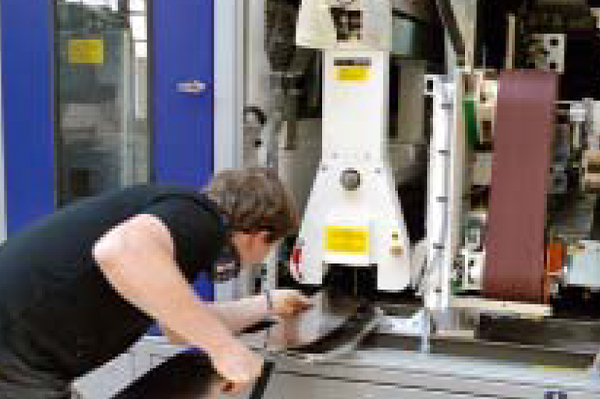“Great effects simply at the push of a button! Now we can sand properly.”

Some call him surface pope. Already 25 years ago, Alfons Wimmer gave lumber an antique look. So far, he has only been able to achieve many effects with extensive manual work. Since the beginning of the year, two new wide belt sanders have been doing this work for him.
Quaint, but sometimes shiny
RIGHT AND LEFT of the visitor entrance to Alfons Wimmer’s 25-man shrine in Mühldorf, Upper Bavaria, are leaned against untreated, but brushed and sanded boards on the doorframe. The entrance opens to the south so that the boards not only get rain, wind and storm, but also the sun. Alfons Wimmer takes a board, holds it up to the light and strokes it lovingly. He is happy about the natural complexion and the sandblasted structure of the larch wood. Such surfaces are extremely well received by his customers. I follow him inside and find myself in the reception room. The furniture and fittings remind me more of an antique shop than one Carpenter exhibition. On sideboards, tables, the reception counter and windowsills, as in Alfons Wimmer’s office, there are countless wood samples, solid wood, veneered panels, self-made three-layer floor elements or frame and panel doors. The surfaces are sanded, delicately or very strongly structured, stained, patinated, waxed, oiled or lacquered. Some patterns have a precisely ground surface, others a slightly wavy surface, as if the boards had been planned by hand. From rustic to dignify to high-gloss, there is something for every taste. “In Asia, such effects are created by hand. We can only do this economically with the machine”, says Alfons Wimmer. ”That is why we put two new wide belt-sanding machines into operation at the beginning of the year.”
Alfons Wimmer cuts most of the veneers on his own log band saw. Normally cut veneer is steamed and the color no longer matches the solid wood. In addition, the saw veneers, which are usually 3 mm thick, can be structured particularly deeply and even processed with a roughing plane. Scrub planed wood can be compared to a very shallow hilly landscape. So far, the employees have actually created this effect by hand with the roughing plane and then smoothed the surface with the eccentric sander. They also have the rough sawn effect with real saw cuts on the block band saw generated. The old wide belt sanding machine could neither create these effects nor could it structure it as deeply and versatile as Alfons Wimmer had imagined. For two years, he worked intensively on the selection of a new broadband machine and then ordered two different ones from Heesemann.
One for the rough, one for the fine
He uses the smaller and simpler, but more powerful »MFA 10« with one calibration and two brush rollers for the rough, that is, calibrating boards and the self-cut veneer as well as difficult structuring tasks. The calibration roller has a fixed cutting speed for rough calibration work.
The large structuring brush, on the other hand, can be adjusted continuously. For the finer things, he has also ordered the “MFA Impression” model with water-cooled servomotors from Heesemann. These drives allow particularly low speeds so that the machine can sand or polish not only wood, but also paint and plastics. Metals can also be processed.
Water cooled units
Alfons Wimmer chose a cross sanding belt as the first unit. It is followed by a combi longitudinal sanding unit with a link pressure shoe. The carpentry uses it for the contact sanding of solid wood, veneer and lacquer as well as for calibrating plastics with low speed.
Two brushing units follow. The first is equipped with a stainless steel wire brush on the left and a braid wire brush on the right, the second with an Anderlon brush. Usually the second brush runs the other way around than the first to remove the loose fibers. On the machine side, the employees choose whether they want to structure more strongly with the harder brush or only slightly with the softer one. Further parameters are the speeds, the directions of rotation and the pressure that results from the height of the unit.
The last unit is called RUT, which stands for rotating revolving disk brushes. It consists of 19 disk brushes that move across the feed direction over the full sanding width of 1350 mm. The unit can be equipped with wire or abrasive lamellar brushes and sands or structures the entire work piece evenly in different directions, so that, as with the random orbit sander, no visible traces of sanding remain. If the front and back of the sanding lamellas have different grain sizes, the grain size can be selected by changing the direction of rotation without changing the tool.
For the shovel effect, the machine control uses a random generator that controls the sectional pressure beam and sands some regions of the surface and others not. A steel plate with a graphite layer specially segmented for this process is located between the sectional pressure beam and the sanding belt.
Alfons Wimmer achieves the rough-sawn effect with the cross belt with extremely coarse grain at a minimal sanding speed.
Effects without end
Alfons Wimmer sums up his experience with the machines: “A machine for the rough and a jack-of-all-trades for everything else – this concept works with us. We have been working with the machines since the beginning of the year and have soon created 100 programs. All effects can be strengthened or weakened and combined with one another as desired. There are no longer any limits to my creativity and my urge to keep creating new surfaces. In addition, of course, we save a lot of working time because we no longer have to create the effects manually.”


